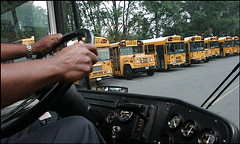More evidence favoring walkable communities
 Fairfax County, which has more than 165,000 students, is short about 180 bus drivers. (By Michael Temchine For The Washington Post). From the article, "Schools Are Facing Acute Shortage of Bus Drivers: Students Feel Effects In Class and at Home."
Fairfax County, which has more than 165,000 students, is short about 180 bus drivers. (By Michael Temchine For The Washington Post). From the article, "Schools Are Facing Acute Shortage of Bus Drivers: Students Feel Effects In Class and at Home."For the last 18 months or so, I've been making this argument in favor of walkable neighborhoods with elementary schools that kids can walk to--that school campuses on the edges of towns require a massive school bus infrastructure (comparable to the deleterious impact of the replacement of streetcar transit systems with buses) requiring drivers, fuel, maintenance, and frequent replacement of buses. Not to mention the number of accidents involving school buses. Even though schoolchildren are unlikely to die in such accidents, drivers of the non-bus vehicles involved in such accidents frequently die.
This is a huge cost to quality of life and our local economies. And another competitive advantage for center cities, provided that we can have a decent public education system...
Index Keywords: urban-design-placemaking; education



0 Comments:
Post a Comment
<< Home